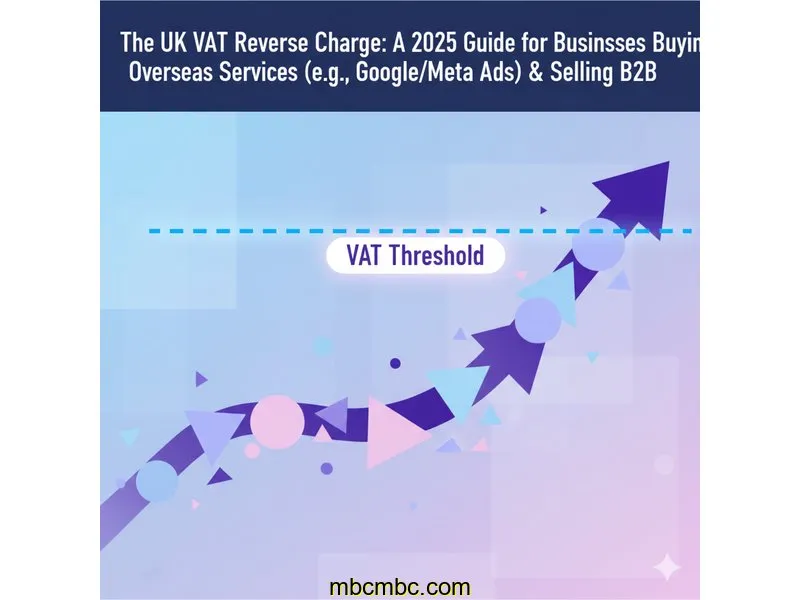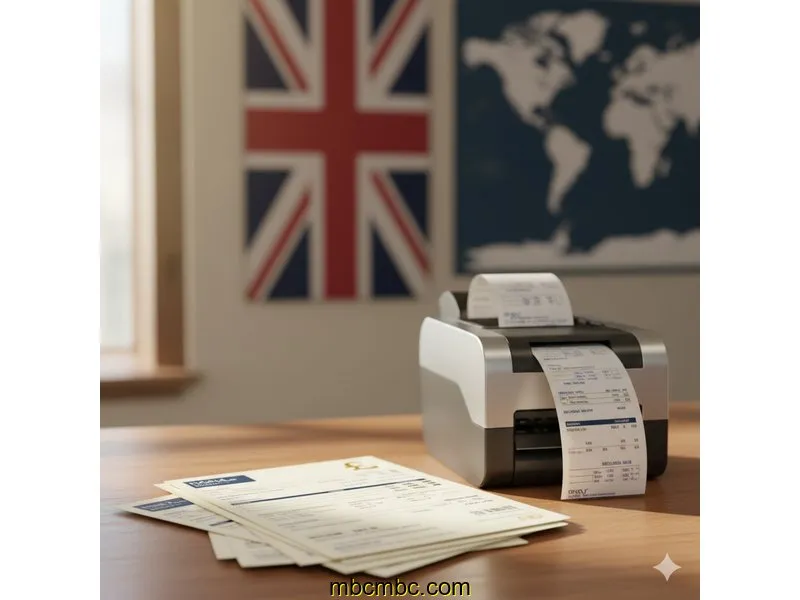
Picture this: You're a VAT-registered graphic designer in Manchester. You just received your monthly invoice from Google Ads for £500. You look at the invoice, and there's no UK VAT. A few days later, you get a £100 invoice from a US-based software company like MailChimp, also with no VAT. You're staring at your accounting software wondering: "Do I just ignore the VAT? Or am I supposed to do something?"
If you've felt this confusion, you are not alone. This is the "VAT reverse charge," and it's one of the most misunderstood concepts for UK small businesses. Getting it wrong isn't just a minor bookkeeping error; it can lead to an incorrect VAT return, potential penalties from HMRC, and a distorted view of your business's finances. A 2024 survey from a UK accounting provider found that over 60% of small business owners find accounting for reverse charge VAT the most confusing part of their quarterly return.
Key Takeaways
- What It Is: The reverse charge is a mechanism where the *buyer* (you) accounts for VAT on services purchased from overseas, rather than the *seller* charging it.
- Who It Affects: UK VAT-registered businesses that buy services from *any* overseas supplier (e.g., Google, Meta, Adobe, US-based SaaS) OR sell B2B services to businesses outside the UK.
- The "VAT Mirror" Analogy: You act as both the supplier and the customer. You add 20% VAT to your purchase (Box 1) and then reclaim that same 20% as an input cost (Box 4).
- The Net Effect: For most businesses, the cash effect is zero, but it is a **mandatory reporting requirement**. Failure to report it is a VAT error.
- Disclaimer: This article provides informational guidance based on HMRC rules as of November 2025 (2025/26 tax year). It is not financial or tax advice. The reverse charge is complex and penalties for errors are significant—always consult a qualified accountant for your specific situation.
Why Does the Reverse Charge Even Exist?
Let's explore the core concept. In a simple domestic transaction, a UK VAT-registered seller charges 20% VAT, and a UK VAT-registered buyer reclaims that 20% VAT. Simple. But what happens when the seller is in the USA?
HMRC cannot force a US company like Adobe or Google to register for UK VAT and file a UK VAT return for every B2B sale. It would be an administrative nightmare. Instead, they shift the responsibility. Think of the reverse charge as a **"customs declaration for services."** HMRC says to the UK business: "That US company *should* have charged you 20% UK VAT. Since they didn't, you must declare the 20% VAT you *would* have paid, and then, because you're a business, you can reclaim it at the same time."
This mechanism prevents overseas suppliers from having an unfair 20% price advantage over UK suppliers. It ensures VAT is accounted for on services consumed within the UK, regardless of where the supplier is based. This is all governed by HMRC's "place of supply" rules. For most B2B services, the place of supply is deemed to be where the *customer* (you) is located (HMRC VAT Notice 741A, 2025). This is why those US invoices correctly show 0% VAT—the service is "supplied" in the UK, making you responsible for the VAT accounting.
Scenario-Based Breakdown: Buying vs. Selling Services
The reverse charge rule applies differently depending on whether you are the buyer or the seller. To make sense of this, let's break down the four most common scenarios for a UK VAT-registered freelancer or small business. For this, we'll assume the UK VAT threshold is £90,000 (HMRC, 2024) and you are registered.
| Scenario | Your Role | Service & Location | What You Charge / Report | What You Must Do on Your VAT Return |
|---|---|---|---|---|
| 1. Buying US Software | Buyer | £100/mo software subscription from a US company (e.g., MailChimp, Adobe) | Supplier charges £100 (0% VAT). You must "reverse charge" 20% (£20). | Add £20 to Box 1 (Output VAT). Add £20 to Box 4 (Input VAT). Add £100 to Box 6 & 7 (Net values). |
| 2. Buying EU Services | Buyer | £1,000 invoice from a freelance developer in Ireland (EU) | Supplier charges £1,000 (0% VAT) after you provide your UK VAT number. You must "reverse charge" 20% (£200). | Add £200 to Box 1 (Output VAT). Add £200 to Box 4 (Input VAT). Add £1,000 to Box 6 & 7 (Net values). |
| 3. Selling B2B to EU | Seller | £5,000 consulting service to a German company (with a valid EU VAT number) | You charge £5,000 (0% VAT). The German customer performs the reverse charge in Germany. | Do NOT charge UK VAT. Verify their VAT number. Include the £5,000 sale in Box 6 (Net sales). |
| 4. Selling B2B to USA | Seller | £2,000 design service to a US company (California) | You charge £2,000 (0% VAT). This is "Outside the Scope" of UK VAT. | Do NOT charge UK VAT. This sale is outside the scope of UK VAT and does not go in Box 1 or Box 6. (Check with an accountant, as reporting can vary). |
As you can see, the most common action for UK businesses is **Scenario 1 & 2: Buying overseas services.** This is where the "VAT Mirror" analogy comes in. You are pretending to be both the seller (adding £20 to Box 1) and the buyer (reclaiming £20 in Box 4). The net cash impact on your VAT bill is zero, but you *must* report it correctly. Failure to do so means your Box 1 and Box 4 are both understated, which is a compliance error.
Deep Dive: How to Practically Account for Reverse Charge
So, you have that £100 invoice from MailChimp. How do you *actually* do this? Most modern accounting software (like Xero, QuickBooks, or FreeAgent) has a specific VAT rate for this, often called "Reverse Charge 20%" or "Imported Services - 20%."
When you use this code, the software automatically does the following on your VAT return:
Step-by-Step: Your VAT Return Boxes Explained
Let's use the £100 MailChimp invoice (which is £100 net) and the 20% VAT rate (£20).
1. Box 1 (Output VAT due): You add the £20 of VAT here. This is the VAT you are "self-declaring" on behalf of your US supplier.
2. Box 4 (Input VAT reclaimable): You also add the £20 of VAT here. This is you, as the VAT-registered business, reclaiming the VAT on a legitimate business expense.
3. Box 6 (Total value of sales): This is unaffected by the *purchase*. (If you were *selling* B2B to the EU, as in Scenario 3, the value of that sale would go here).
4. Box 7 (Total value of purchases): You add the £100 net purchase value here, just as you would for any other business expense.
The final calculation for your VAT bill is (Total Box 1 - Total Box 4). Since you added £20 to both boxes, the net effect on the amount you owe to HMRC is £0. This is why it's a "cashless" transaction, but a critical reporting one.
Edge Cases & Common Traps
The main principles are clear, but there are two traps I see businesses fall into. The first is for businesses that are **partially exempt**. If you make "exempt" sales (like some financial or educational services), you cannot reclaim all your input VAT. In this case, the reverse charge *does* create a real cost, as you add £20 to Box 1 but can only reclaim a *portion* of it in Box 4.
The second trap is the **VAT Flat Rate Scheme (FRS)**. If you are on the FRS, the rules are different. You *still* account for the reverse charge VAT in Box 1, but you generally *cannot* reclaim it in Box 4 (unless it's a capital asset over £2,000). This means the reverse charge represents a real 20% cost to your business. This "trap" is a major reason why the FRS is no longer suitable for many businesses that buy overseas services (HMRC VAT Notice 733, 2024).
Common Questions About the VAT Reverse Charge
Based on questions I've seen across UK freelancer forums and Reddit's r/UKPersonalFinance, here are the most common points of confusion.
1. I'm VAT registered and use US software like Google Ads/Meta Ads. Why do I have to 'reverse charge' VAT and how?
You must do this because the "place of supply" for their advertising service is the UK (where you, the B2B customer, are). Since they are not a UK company, HMRC shifts the VAT accounting to you. You must take their £0-VAT invoice (e.g., £1,000), calculate the 20% VAT (£200), and add that £200 to *both* Box 1 and Box 4 of your VAT return. Your accounting software has a specific VAT code for this.
2. I'm selling a digital service to a German company with a valid VAT number. Do I charge 20% VAT or 0%?
You charge 0%. This is a B2B service supplied to an EU business. The place of supply is Germany. You must validate their EU VAT number (using the VIES online checker), show it on your invoice, and state "Services subject to reverse charge" on the invoice. Your customer will then account for the German VAT in Germany. You report the net value of this sale in Box 6 of your UK VAT return.
3. Does the reverse charge mean I actually pay more tax? It looks like I'm adding VAT to my expenses.
For the vast majority of UK businesses, **no, it does not cost you anything.** It is a reporting-only exercise. You add £20 of VAT to your "VAT owed" (Box 1) but simultaneously add £20 to your "VAT reclaimed" (Box 4). The two cancel each other out. The only common exceptions are if you are on the Flat Rate Scheme or are a partially exempt business (e.g., you sell a mix of standard and VAT-exempt services).
Conclusion: Your Next Steps

Understanding the VAT reverse charge transforms it from a source of confusion into a simple, logical process. It's HMRC's solution to taxing cross-border digital services, and it puts the reporting burden squarely on you, the VAT-registered buyer. The "VAT Mirror" is your best mental model: you declare the VAT (Box 1) and reclaim the VAT (Box 4) in one go.
If you are a VAT-registered UK business, your immediate next step is to review your overseas subscriptions (software, advertising, hosting, etc.). Are you correctly applying the reverse charge to them? Most accounting software makes this simple with a dedicated VAT code. If you are not, you are technically filing incorrect VAT returns. For most, this won't result in underpaid VAT, but it's a compliance error you should fix. As always, VAT rules are notoriously complex—this guide provides a framework, but for your specific business setup, please consult a qualified VAT accountant.

